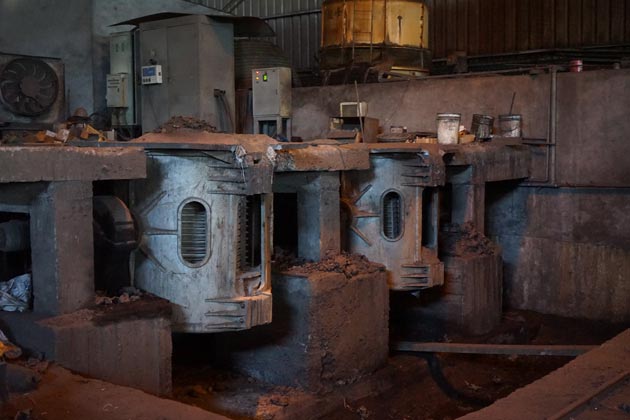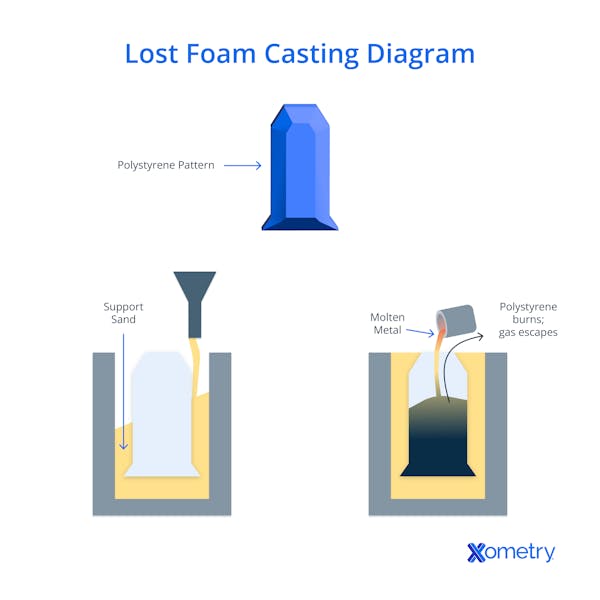Just How Aluminum Foundry Contributes to Developments in Aerospace Design
Aluminum foundries are indispensable to advancements in aerospace design. They create light-weight, high-strength parts that are crucial for modern-day airplane. Through advanced spreading methods, these factories develop complex geometries that improve structural honesty. Additionally, the growth of exceptional Aluminum alloys sustains the industry's concentrate on gas efficiency and sustainability. Difficulties continue to be in the manufacturing procedure. Understanding these variables discloses the extensive impact of Aluminum on aeronautics's future.
The Importance of Lightweight Products in Aerospace Design
As the aerospace sector proceeds to progress, the relevance of lightweight materials ends up being significantly evident. The demand for effectiveness and sustainability drives engineers to prioritize making use of products that decrease overall weight without jeopardizing architectural integrity. Light-weight materials, especially Aluminum, play a crucial function in improving gas efficiency, boosting haul capacity, and enhancing the total performance of aircraft.
The integration of these materials enables for ingenious styles, allowing producers to produce more wind resistant shapes that can endure extreme conditions. The decrease in weight not just reduces functional expenses however also adds to a reduced environmental impact, aligning with worldwide efforts toward sustainability in aviation.
Advanced Spreading Techniques in Aluminum Foundries
Advanced casting techniques in Aluminum factories play an important role in aerospace engineering by enabling the production of exact and light-weight elements. Advancements in mold design and precision casting processes are essential in accomplishing perfect performance and architectural integrity. In addition, the advancement of light-weight alloys improves the total effectiveness and efficiency of aerospace applications.
Cutting-edge Mold And Mildew Style
Ingenious mold layout plays a vital role in the effectiveness and efficiency of Aluminum factories, especially within the aerospace industry. By leveraging advanced products and techniques, modern-day molds can be crafted to withstand heats and pressures, guaranteeing peak performance throughout the spreading procedure. These styles commonly include intricate geometries that allow for the manufacturing of lightweight yet structurally audio parts, important for aerospace applications. Furthermore, the use of computer-aided style (CAD) software application facilitates exact modeling, making it possible for foundries to refine and replicate mold and mildew designs before physical production begins. This not just boosts the quality of cast components yet also minimizes waste and lead times, bring about considerable price savings. Overall, ingenious mold design is a foundation of development in Aluminum Foundry modern technology for aerospace design.
Precision Casting Procedures
The effectiveness of innovative mold and mildew layouts perfectly integrates with accuracy spreading processes, which are crucial for producing high-grade Aluminum parts in aerospace engineering. These processes, including sand spreading, pass away spreading, and financial investment spreading, guarantee the creation of complicated geometries with tight tolerances. Advanced methods like vacuum cleaner spreading and stress pass away casting boost the honesty and surface coating of the last items. Precision spreading minimizes product waste while making the most of the mechanical homes of Aluminum, critical for aerospace applications. Furthermore, utilizing real-time monitoring and progressed simulation tools throughout the casting procedure permits immediate adjustments, resulting in boosted quality assurance. Collectively, these accuracy spreading procedures placement Aluminum shops at the center of aerospace innovation, sustaining the market's need for dependability and performance.
Light-weight Alloy Growth
As aerospace engineers look for to boost gas effectiveness and performance, light-weight alloy advancement becomes a necessary focus in Aluminum foundries. These foundries use sophisticated casting techniques to develop alloys that supply exceptional strength-to-weight proportions. Innovations in alloy structure, including the incorporation of aspects like lithium and magnesium, enable the manufacturing of products that hold up against severe problems while lowering general aircraft weight. Techniques such as die spreading and financial investment spreading assist in the precision production of complex shapes, which are critical for aerospace applications. Additionally, recurring study intends to optimize these alloys for enhanced mechanical residential properties and boosted longevity. By prioritizing lightweight alloy growth, Aluminum factories greatly add to the evolution of aerospace design, leading the way for extra sustainable and effective aircraft designs.

Enhancing Architectural Stability Through Aluminum Parts
Aluminum components supply significant benefits in improving architectural stability within aerospace engineering. Their light-weight nature adds to overall performance while maintaining toughness, which is vital for aircraft efficiency. Additionally, the stress and anxiety resistance residential properties of Aluminum help assure the resilience and reliability of aerospace frameworks under various operational problems.
Lightweight Product Benefits
While standard products frequently endanger weight for toughness, using Aluminum elements in aerospace engineering supplies substantial benefits in architectural stability. Aluminum's light-weight nature adds to overall style performance, enabling even more streamlined aircraft that consume less fuel, therefore improving sustainability. The material's outstanding strength-to-weight proportion guarantees that elements maintain resilience without adding unnecessary mass. This top quality promotes boosted performance and dexterity in flight, along with maximized payload abilities. Furthermore, Aluminum's resistance to corrosion prolongs the life expectancy of aerospace structures, decreasing upkeep expenses and boosting safety. As suppliers increasingly embrace Aluminum alloys, the aerospace market experiences a transformative shift towards much more effective and effective design remedies that focus on both performance and environmental duty.
Stress Resistance Properties
Although numerous products possess one-of-a-kind homes, Aluminum's exceptional tension resistance stands apart as a critical consider improving the structural honesty of aerospace components. This resistance plays an essential role in guaranteeing that aircraft can endure numerous functional stress and anxieties, including fatigue, influence, and ecological conditions. Aluminum alloys, especially crafted for aerospace applications, exhibit high tensile stamina while keeping lightweight attributes, making it possible for engineers to create extra effective frameworks - Aluminum Foundry. In addition, the capability of Aluminum to sustain cyclic loading without significant contortion adds to the longevity and integrity of aerospace elements. As advancements proceed in Aluminum Foundry techniques, the growth of stress-resistant Aluminum elements guarantees additional improvements in efficiency, safety, and efficiency throughout the aerospace industry, strengthening Aluminum's role as a recommended product in contemporary design
Gas Effectiveness Improvements Driven by Aluminum Innovations
As the aerospace market looks for to boost fuel efficiency, cutting-edge uses of Aluminum have actually become a crucial solution. Aluminum's light-weight nature significantly reduces aircraft weight, allowing for lower fuel intake throughout flight. This reduction in weight is vital, as even little declines can cause substantial improvements in overall gas economic climate.
Advanced Aluminum alloys, developed for boosted strength and sturdiness, enable suppliers to develop elements that maintain architectural honesty while minimizing mass - Aluminum Foundry. Furthermore, the assimilation of Aluminum in airframes and engine elements assists in enhanced the rules of aerodynamics, adding to decreased drag and raised efficiency
The fostering of Aluminum in aerospace not only meets the demand for fuel-efficient design but additionally aligns with regulatory pressures for reduced exhausts. As these innovations proceed to develop, they play a considerable function in establishing new standards for gas efficiency, making sure that the aerospace industry can meet expanding ecological and economic challenges.

The Duty of Aluminum in Sustainable Aviation Practices
The raising focus on lasting air travel practices has placed Aluminum as an essential product in the mission for greener airplane design. Recognized for its light-weight residential or commercial properties, discover this info here Aluminum significantly reduces aircraft weight, causing reduced gas consumption and exhausts. Its recyclability additionally enhances its sustainability account, as Aluminum can be reused indefinitely without loss of high quality. This particular sustains a round economic situation within the aeronautics field, decreasing waste and resource deficiency.
Improvements in Aluminum alloys have actually improved their strength and corrosion resistance, allowing for longer service life and lowered maintenance needs. These innovations help with the development of extra reliable aircraft frameworks, contributing to overall sustainability initiatives. Additionally, Aluminum's thermal conductivity plays an essential role in energy-efficient layouts, boosting systems such as heat exchangers. Collectively, these attributes emphasize Aluminum's pivotal function in progressing sustainable aeronautics, lining up with international efforts targeted at decreasing the ecological influence of air travel.
Challenges Encountered by Aluminum Foundries in Aerospace Production
While Aluminum factories play a necessary duty in aerospace manufacturing, they face substantial difficulties that can influence manufacturing efficiency and top quality. One major difficulty is the stringent quality assurance requirements required in the aerospace market. Any type of issue can jeopardize safety and security and performance, necessitating rigorous inspection procedures that prolong manufacturing timelines. Additionally, factories frequently contend with rising and fall resources costs, which can influence pricing and profitability. The complexity of Aluminum use this link alloys made use of in aerospace applications additional makes complex the production process, as exact formulations are crucial for achieving wanted mechanical residential or commercial properties. Furthermore, proficient labor scarcities hinder the capacity to maintain high-grade manufacturing levels. Finally, environmental policies enforce limitations on discharges and waste management, needing factories to buy sustainable practices, which can be cost-prohibitive. These factors jointly create a landscape where Aluminum foundries should constantly adjust to satisfy the developing needs of aerospace manufacturing while ensuring safety and security and compliance.
Future Trends in Aluminum Applications for Aerospace Engineering
With advancements in technology and boosting demands for performance, the future of Aluminum applications in aerospace design is poised for substantial transformation. The combination of innovative Aluminum alloys and compounds is expected to enhance strength-to-weight proportions, leading to more fuel-efficient airplane layouts. On top of that, developments in additive manufacturing strategies will certainly enable for the manufacturing of intricate Aluminum structures that were previously impossible, maximizing efficiency and lowering waste.

Lasting practices will certainly play a necessary role, with an expanding focus on recycling Aluminum to decrease ecological impact. The aerospace field is most likely to embrace smarter manufacturing procedures, such as automation and expert system, guaranteeing better and accuracy in Aluminum elements. Furthermore, partnerships between Aluminum shops and aerospace firms will foster research study and development, paving the way for brand-new applications that fulfill the stringent requirements of contemporary aerospace engineering - Aluminum Foundry. Generally, the future looks guaranteeing for Aluminum's role in shaping the skies
Frequently Asked Concerns
What Are the Ecological Influences of Aluminum Production in Aerospace?
The environmental impacts of Aluminum manufacturing in aerospace consist of significant power consumption, greenhouse gas exhausts, and habitat interruption. Furthermore, mining processes can result in soil deterioration and water contamination, elevating issues about sustainability and environmental equilibrium.
How Does Aluminum Compare to Various Other Products in Aerospace Applications?
Aluminum supplies a distinct combination of light-weight residential properties, deterioration resistance, and cost-effectiveness compared to other products. Its high strength-to-weight ratio makes it particularly helpful for aerospace applications, improving gas effectiveness and overall performance in airplane design.
What Certifications Do Aluminum Foundry Workers Demand for Aerospace Projects?
Aluminum Foundry employees call for specialized training in metallurgy and spreading strategies, together with knowledge of aerospace market requirements. Certifications in quality control and safety procedures are additionally important to assure conformity with strict aerospace task requirements.
Are There Any Kind Of Security Worry About Utilizing Aluminum in Aerospace Design?
Safety and security problems pertaining to Aluminum in aerospace engineering consist of sensitivity to exhaustion, deterioration, and tension cracks. Proper treatment and alloy option are important to reduce these risks, guaranteeing architectural integrity and general Read Full Report safety and security in aerospace applications.
Just How Does Aluminum Recycling Benefit the Aerospace Industry?
Aluminum recycling greatly benefits the aerospace market by decreasing product expenses, reducing ecological influence, and saving energy. This sustainable method improves the sector's efficiency while promoting using light-weight, high-performance elements in aircraft manufacturing.
Advanced casting techniques in Aluminum shops play a crucial function in aerospace design by enabling the production of accurate and lightweight components. Innovative mold and mildew layout plays a necessary function in the performance and efficiency of Aluminum factories, particularly within the aerospace market. As aerospace engineers seek to improve gas efficiency and performance, light-weight alloy development ends up being an important emphasis in Aluminum foundries. Aluminum alloys, particularly crafted for aerospace applications, display high tensile stamina while maintaining light-weight characteristics, making it possible for engineers to develop extra reliable structures. Cooperations between Aluminum foundries and aerospace companies will cultivate research study and development, paving the means for new applications that fulfill the strict needs of contemporary aerospace engineering.